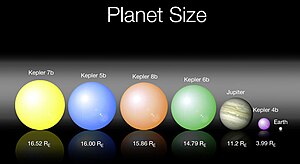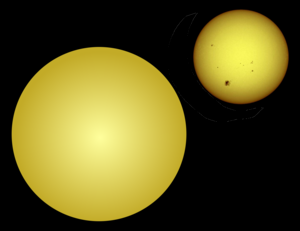Kepler-7
| Observation data Epoch J2000 Equinox J2000 | |
|---|---|
| Constellation | Lyra |
| Right ascension | 19h 14m 19.5623s[1] |
| Declination | +41° 05′ 23.367″[1] |
| Apparent magnitude (V) | 13.005±0.039[2] |
| Characteristics | |
| Spectral type | G0[3] |
| Apparent magnitude (J) | 11.833±0.020[4] |
| Apparent magnitude (H) | 11.601±0.022[4] |
| Apparent magnitude (K) | 11.535±0.020[4] |
| Apparent magnitude (B) | 13.620±0.029[2] |
| Details Gyr | |
| Other designations | |
| Database references | |
| SIMBAD | data |
Kepler-7 is a
Nomenclature and discovery
Kepler-7 received its name because it was the home to the seventh planetary system discovered by the NASA-led Kepler Mission, a project aimed at detecting
The planet's initial discovery by Kepler was verified by additional observations made at observatories in Hawaii, Texas, Arizona, California, and the Canary Islands.[9]
Characteristics
Kepler-7 is a sunlike star that is 1.347

The star has an apparent magnitude of 13,[2] meaning that it is extremely dim as seen from Earth. It cannot be seen with the naked eye.[8] It is estimated to lie at approximately 3160 light years from the Solar System.[1]
There is a star that is 4 magnitudes dimmer located 1.90 arcseconds away, whether this a gravitationally bound companion star or a chance optical alignment is unknown.[14]
Planetary system
Kepler-7b is the only planet that has been discovered in Kepler-7's orbit. It is .433 MJ and 1.478 RJ, meaning it is 43% the mass of planet Jupiter, but is nearly three halves its size. With a density of .166 grams/cc,[8] the planet is approximately 17% the density of water. This is comparable to styrofoam.[6] At a distance of .06224 AU from its host star, Kepler-7b completes an orbit around Kepler-7 every 4.8855 days.[8] Planet Mercury, however, orbits the Sun at .3871 AU, and takes approximately 87.97 days to complete one orbit.[15] Kepler-7b's eccentricity is assumed to be 0, which would give Kepler-7b a circular orbit by definition.[8]
| Companion (in order from star) |
Mass | Semimajor axis (AU) |
Orbital period (days) |
Eccentricity | Inclination | Radius |
|---|---|---|---|---|---|---|
| b | 0.433 MJ | 0.06224 | 4.8855 | 0 | — | 1.478 RJ |
See also
- List of extrasolar planets
References
- ^ S2CID 244398875. Gaia DR3 record for this source at VizieR.
- ^
- ^ a b "Kepler-7". SIMBAD. Centre de données astronomiques de Strasbourg. Retrieved 2018-11-24.
- ^ S2CID 18913331. Vizier catalog entry
- ^ .
- ^ a b c Rich Talcott (5 January 2010). "215th AAS meeting update: Kepler discoveries the talk of the town". Astronomy.com. Astronomy magazine. Retrieved 27 February 2011.
- ^ Johnson, Michele, ed. (2018-10-30). "Mission overview". www.nasa.gov. NASA. Retrieved 2018-11-24.
- ^ a b c d e f "Summary Table of Kepler Discoveries". NASA. 2010-01-04. Archived from the original on 2010-05-27. Retrieved 2010-01-06.
- ^ "NASA's Kepler Space Telescope Discovers its First Five Exoplanets". NASA. 4 January 2010. Retrieved 27 February 2011.
- ^ Henry Bortman (12 October 2004). "Extrasolar Planets: A Matter of Metallicity". Space Daily. Retrieved 27 February 2011.
- ^ "Notes for star Kepler-7". Extrasolar Planets Encyclopaedia. 2010. Archived from the original on 21 January 2011. Retrieved 27 February 2011.
- ^ Fraser Cain (16 September 2008). "How Old is the Sun?". Universe Today. Retrieved 27 February 2011.
- ^ David Williams (1 September 2004). "Sun Fact Sheet". Goddard Space Flight Center. NASA. Retrieved 27 February 2011.
- .
- ^ David Williams (17 November 2010). "Mercury Fact Sheet". Goddard Space Flight Center. NASA. Retrieved 27 February 2011.
External links
Boyle, Alan (30 September 2013). "How astronomers mapped the patchy clouds of an alien world". NBC News. Retrieved 3 October 2013.

